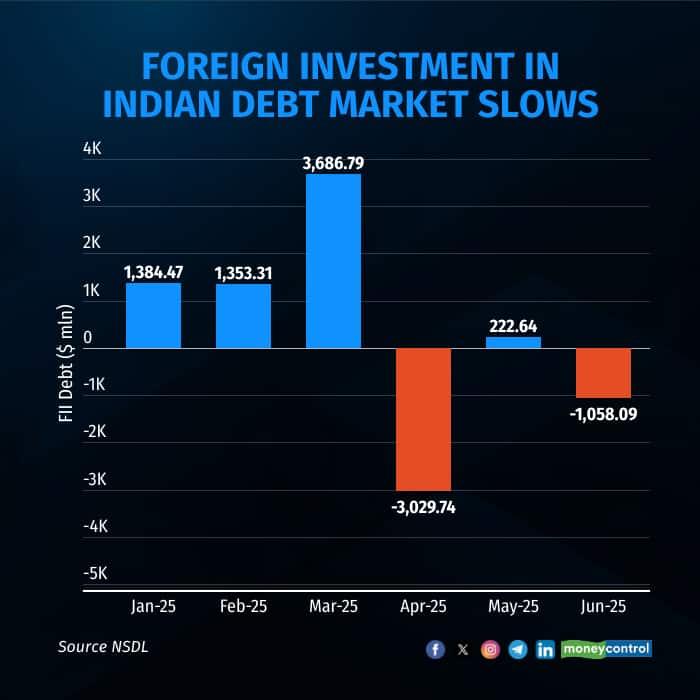



Foreign investment in India’s debt market has slowed down in recent months due to global uncertainties like tariff hikes and economic slowdown, as well as domestic factors such as falling interest rates that reduce the return gap between Indian and US bonds, analysts said.
In June, foreign portfolio investors (FPIs) pulled out over $1.06 billion from Indian debt, after a sharp outflow of $3.03 billion in April. May saw a small inflow of $220 million, mainly due to the Shapoorji Pallonji bond issue. Without that, FPIs would have continued to be net sellers.

Radhika Rao, Senior Economist at DBS Bank, noted that June’s outflows were concentrated in the Fully Accessible Route (FAR) segment, reflecting a wider regional trend. Investors were also waiting for more attractive entry levels amid a narrowing yield spread between Indian government bonds and US Treasuries.
According to market participants, while there have been outflows from Indian debt, especially government securities included in global bond indexes, foreign investors have increased their holdings in short-term bonds. This is because they expect better liquidity after the RBI's planned CRR cut from September, which will inject Rs 2.5 lakh crore into the banking system.
This added liquidity is expected to push down yields on short-term bonds, boosting their prices. So, investing in these bonds now could result in higher returns when yields start falling.
The holdings of foreign investors in bonds such as 5.63 GS 2026, 5.74 GS 2026, 7.02 GS 2031, 6.54 GS 2032, 7.04 GS 2029, among others, have increased up to 300 bps, according to the Clearing Corporation of India’s (CCIL) data.
Recently, the domestic yield curve shifted higher in response to the Reserve Bank of India’s (RBI) decision to frontload rate cuts, adopt a neutral stance, and set a high bar for further easing. Calming remarks from the RBI Governor subsequently helped stabilise bond prices.
A few experts suggested the India-US 10-year bond yield spread has remained below 200 basis points for some time, reducing the carry advantage. Although oil prices have now stabilised, recent volatility, combined with sharp movements in the rupee, has added to investor caution.
Venkatakrishnan Srinivasan, Founder and Managing Partner at Rockfort Fincap, explained that heightened currency risk has made Indian assets less attractive. Even with the RBI’s dovish pivot, FIIs remain cautious in a risk-off environment, prioritising safety over limited yield pick-up.
That said, the improving domestic macroeconomic backdrop and the government’s commitment to fiscal consolidation offer a supportive environment for bonds. Experts expect flows into emerging market duration assets to resume as US yields better reflect softer economic data and the dollar weakens.
Disclaimer: The views and investment tips expressed by investment experts on Moneycontrol.com are their own and not those of the website or its management. Moneycontrol.com advises users to check with certified experts before making any investment decisions.
Discover the latest Business News, Sensex, and Nifty updates. Obtain Personal Finance insights, tax queries, and expert opinions on Moneycontrol or download the Moneycontrol App to stay updated!
Find the best of Al News in one place, specially curated for you every weekend.
Stay on top of the latest tech trends and biggest startup news.